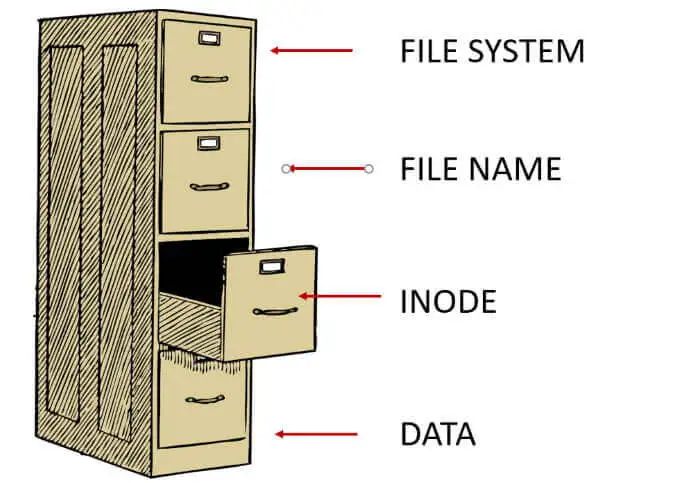When we think about computer storage, we often picture files and directories, maybe even the sectors on a disk. However, the true backbone of file management in many filesystems is something much less visible: the inode. This blog post aims to demystify inodes, explain their crucial role in file management, and highlight their importance in ensuring efficient and reliable storage systems.
Table of Contents
What is an Inode?

An inode (Index Node) is a data structure used in many Unix-like filesystems, such as ext3, ext4, and UFS, to store information about a file or a directory. Unlike the file itself, which holds data, an inode holds metadata about the file. This metadata includes:
- File type (e.g., regular file, directory, symbolic link)
- Permissions (read, write, execute)
- Owner and group information
- File size
- Timestamps (creation, modification, access)
- Link count (number of hard links pointing to the inode)
- Pointers to the actual data blocks on the disk
Essentially, an inode is an entry in a table maintained by the filesystem, where each entry corresponds to a file or directory.
The Role of Inodes in Filesystems
Inodes are fundamental to how filesystems manage and organize data. Here’s how they fit into the broader picture:

- File Creation and Deletion: When a new file is created, the filesystem allocates a new inode, which then gets populated with the file’s metadata. Deleting a file involves updating the inode’s link count and, if it reaches zero, freeing the inode and its associated data blocks.
- Data Storage: Its contain pointers to data blocks on the disk. These pointers can be direct, indirect, or even doubly or triply indirect. Direct pointers link directly to the data blocks, while indirect pointers link to blocks that contain further pointers. This hierarchical structure allows filesystems to efficiently manage both small and large files.
- Access Control: It store information about file ownership and permissions. This information is critical for enforcing security policies and ensuring that only authorized users can access or modify files.
- File Operations: When you open, read, write, or execute a file, the operating system uses the inode to locate the file’s data blocks. This process involves reading the inode’s metadata and following the pointers to the actual data.
Inodes and Filesystem Efficiency
Efficient inode management is crucial for the overall performance of a filesystem. Here are some key considerations:

- Space Utilization: Inodes themselves consume space on the disk. Therefore, a balance must be struck between having enough inodes to accommodate files and not wasting disk space. Filesystems typically allocate a fixed number of inodes when they are created, based on an estimate of the expected number of files.
- Performance: Accessing file data involves reading inodes and following their pointers. The organization and caching of inodes can significantly impact the performance of file operations. For example, frequently accessed inodes are often kept in memory to speed up subsequent access.
- Scalability: As filesystems grow in size, managing inodes efficiently becomes more challenging. Advanced filesystems employ various techniques, such as inode clustering and dynamic inode allocation, to address these challenges and ensure scalability.
Practical Aspects of Inode Management
It can help system administrators and users optimize filesystem performance and troubleshoot issues. Here are some practical aspects to consider:
- Inode Utilization: Monitoring inode utilization is essential, especially on filesystems with a large number of small files. Running out of inodes can prevent new files from being created, even if there is free disk space. Tools like
df -ion Unix-like systems can be used to check inode usage. - Filesystem Design: When setting up a new filesystem, it’s important to consider the expected number and size of files. Filesystems designed to store many small files might benefit from a higher inode density, while those storing large files might not need as many inodes.
- Repair and Recovery: Filesystem corruption can affect inodes, leading to data loss or inaccessibility. Tools like
fsck(filesystem check) can detect and repair inode-related issues. Regular backups are also crucial to mitigate the risk of inode corruption.
Inodes in Different Filesystems
While the concept of inode is common across many Unix-like filesystems, the implementation details can vary. Here’s a brief look at inodes in some popular filesystems:

- ext3/ext4: These are among the most widely used filesystems in Linux. They use a fixed number of inodes, allocated when the filesystem is created. Ext4 introduces improvements like extents (a way to efficiently store large contiguous blocks) and delayed allocation to optimize performance.
- XFS: Known for its scalability and performance, XFS uses dynamic inode allocation. Inodes are created as needed, rather than being pre-allocated, which helps in efficiently managing disk space.
- ZFS: A high-performance filesystem with advanced features like data integrity and snapshots. ZFS does not use traditional inode but has a similar concept called dnodes (data nodes) that store metadata and pointers to data.
- Btrfs: Another modern filesystem with features like snapshots, subvolumes, and checksums for data integrity. Btrfs uses dynamic inode allocation, similar to XFS, to manage space efficiently.
The Future of Inodes
As storage technology evolves, the role and implementation of inode may continue to change. Emerging trends include:
- Non-volatile Memory: The rise of non-volatile memory (NVM) technologies, such as NVMe and Intel Optane, offers the potential for new filesystem designs that can leverage the high speed and low latency of NVM. This could lead to innovations in inode management and data access.
- Distributed Filesystems: In distributed filesystems like Ceph and GlusterFS, inode management becomes more complex due to the need to coordinate metadata across multiple nodes. These filesystems use advanced algorithms and data structures to maintain consistency and performance.
- Filesystem Metadata Enhancements: Future filesystems may incorporate more sophisticated metadata structures, providing richer information and improving performance. This could include extended attributes, finer-grained timestamps, and enhanced security features.
Conclusion
Inodes are the unsung heroes of filesystems, playing a critical role in managing file metadata, ensuring efficient data access, and supporting file operations. Understanding inodes and their importance can help users and administrators optimize filesystem performance, troubleshoot issues, and make informed decisions about storage solutions.
As technology continues to evolve, so too will the concepts and implementations of inodes, paving the way for more advanced and efficient filesystems. Whether you’re a casual user, a system administrator, or a developer, a deeper understanding of inodes can enhance your appreciation of the complex inner workings of modern storage systems.



